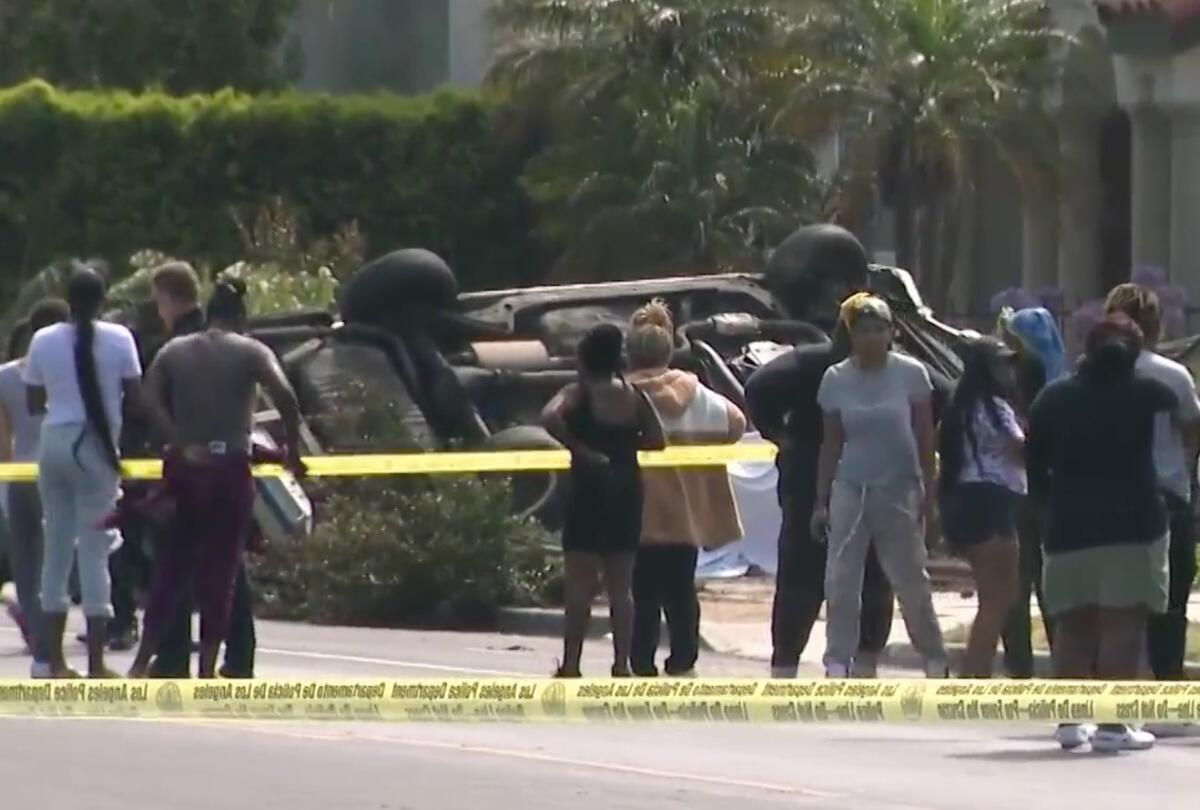Editorial: L.A.’s murderous deja vu

- Share via
The jump in homicides that began in 2020 and continues unabated this year is part of a deadly feedback loop set in motion by COVID-19. The pandemic brought us lockdowns and shutdowns, disrupting life’s daily patterns and at least temporarily dissipating our sense of security and our confidence in societal structures and institutions. Many people got sick, many hunkered down and some — too many — bought guns. Tempers, anxieties, anger and outrage, bottled up for months, erupted in bursts. For some few, they were bursts of killing.
Homicides are up 25% in Los Angeles this year, mirroring increases across the nation. The Fourth of July weekend was especially bloody. Summer usually brings an increase in killing, and this one has just begun.
We have been here, or somewhere that feels somewhat like it, before, and we responded with mistakes that fueled the feedback loop. Let’s not do that again.
There’s a perception in some quarters that we’re back in the middle of the high-crime era of the 1980s and ’90s, but that’s way off base. The murder rate in 1980 was 10 per 100,000 Americans, and even today it is half that.
Still, the recent increase is nevertheless real and worrisome. More people are indeed being viciously killed than in 2019.
In the high-crime era, we responded by flooding police departments and prison systems with funding. The Violent Crime Control and Law Enforcement Act of 1994, now sometimes called the Biden crime bill because of the current president’s role in getting it through the Senate, allocated funding for 100,000 new police officers and tens of thousands of new prison cells nationwide. One result was ever-more brutal policing of the mostly Black and Latino neighborhoods where crime was highest. Instead of feeling relief from crime, residents became caught in a vise, with oppressive and violent gangs and other predators threatening them on one side and oppressive and violent police clamping down on the other.
The targets then were illegal drugs and guns, and the people who sold and used them. We’ve begun to roll back the excessive response to drugs and should continue to treat their use more like the public health issue that they are.
Police still, understandably and appropriately, go after guns. But how to do it? The notorious stop-and-frisk policies that New York police stepped up in the first decade and a half of this century were intended to find and confiscate the weapons that were killing so many people in Black and Latino neighborhoods. But most of the people who were searched were innocent and certainly felt no safer for being targeted. When pedestrian stops plummeted, gun crimes did not jump in response, but continued to decline until the disaster that was last year.
In Los Angeles, police employed the city’s brand of stop-and-frisk, pulling over drivers on minor violations and using the occasion to search cars for illegal weapons. The result was similar: rising anger toward police and too few gun confiscations to make much difference in the murder rate.
Today, some argue that violence is a direct result of defunding the police, a movement and a slogan that became prominent in the wake of the police killing of George Floyd in Minneapolis last year. This is what you get, the argument goes, when you attack the very people who put their lives on the line to protect you from harm.
But of course we haven’t defunded police. Although there has been talk about slashing police budgets and “reimagining” their role, most cities haven’t done it. The Los Angeles Police Department’s budget is up slightly over last year’s.
So, the next argument goes, it’s because we’ve disrespected the police, blaming them for crime-fighting tactics that we’d rather not know about. And there may indeed be some measure of “Minneapolis effect,” in which police modify their actions for fear (or resentment) of criticism. But it would be foolish to believe that police cannot effectively do their jobs unless they are given free rein to do their work without criticism or oversight.
Public safety need not be a zero-sum game, with society left to choose between overbearing policing and rising murder rates — or between either of those extremes and even an attempt to find some acceptable balance. With thought, with work, with trial and error, and most likely with an approach that improves people’s lives and their sense of safety and security, we can do better. We got it wrong in the 1990s. It’s time to get it right.
More to Read
A cure for the common opinion
Get thought-provoking perspectives with our weekly newsletter.
You may occasionally receive promotional content from the Los Angeles Times.










